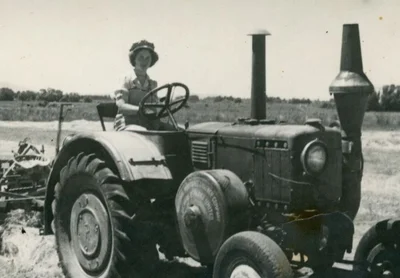Women’s Land Service saves the day

Over the last few months, Ashburton Museum senior curator Maryann Cowan and the rest of the team were hard at work developing the museum’s new special exhibition, which coincides with ANZAC Day. Home Front Heroines, which is now open at the museum, tells the story of the Women’s Land Service in the Second World War, as well as the stories of local women who served their country by working on local farms.
A great source of information for our exhibition is the book The Land Girls: In a Man’s World 1939 – 1946 by Dianne Bardsley, as well as testemonials and stories from many other sources. Without former members of the Women’s Land Service preserving their memories, and the diligent research of historical experts, this exhibition would not be possible. We are also priviliged to have such an expert coming to talk on the subject: there will be a special talk at 2pm on ANZAC Day, by Marlborough Museum Manager Liz Ward, about the history of the Women’s Land Service and its challenges to 1940s gender norms.
From the beginning of the Second World War, as soldiers began to leave our shores, the problem of labour shortages arose in essential industries, including farming. In places like Britain and the United States, governments were quick to employ women into essential industries, but New Zealand lagged behind in this regard.
By the mid-1940s, the labour shortfall was putting enormous pressure on the government, and so the Women’s War Service Auxiliary (WWSA) was established to assist. In 1941, under the WWSA, the Women’s Land Corps was created to help young unmarried women find work on farms. The situation was not helped much however, as the Women’s Land Corps was not run efficiently, and it was initially a struggle to attract women to the scheme. There was demand to improve the service as women faced problems such as gender bias and low pay.
Compelled to serve
As the war continued to wage, more of New Zealand’s workforce was lost to the armed forces. Paired with increased food production demands to feed British citizens, New Zealanders overseas, and United States forces in the Pacific, the government reconsidered how to meet its industrial labour requirements. Conscription for men and women on the home front was introduced in 1942, and women were directed to work in essential industries including in woollen mills, hospitals, freezing works, tobacco, canning, and munitions factories.
That year, the Women’s Land Corps was reformed as the Women’s Land Service. The recruitment and placement processes were streamlined, and better pay rates were introduced alongside training, dress and working uniforms, and the former ban on working for relatives was lifted.
To be a ‘Land Girl’, one had to be at least 17 years old, 18 to work on a relative’s farm, and if under the age of 21, provide written consent from a parent or guardian. Those working on dairy farms received a weekly salary of 35 shillings, which increased to 2 pounds and 1 shilling after six months. To put these figures into perspective, in 1939 the average man earned 253 pounds a year, while the increased rate that Land Girls earned would amount to just over 104 pounds per annum.
“Land Girl” versus “Shop Assistant”
Adding to a prevailing sense that the Land Girls were underappreciated, public perceptions of members of the Women’s Land Service were not always favourable. General criticism and sexism towards the Women’s Land Service ‘Land Girls’ came from both men and women, some of which is captured in the historical record. For instance, over the course of several days in November 1942, a series of letters were published in the Ashburton Guardian. This sequence of correspondence was between three anonymous writers: ‘Land Girl’, ‘Another Land Girl’, and ‘Shop Assistant’.
‘Shop Assistant’ objected heavily to a suggestion by a member of the public that more women should be called from shops, offices, and domestic positions to undertake essential work. They claimed that the majority of land girls serving on the home front “couldn’t put a chicken in a coop”. After also implying that land girls did little work, two responses were published in the Ashburton Guardian from members of the Women’s Land Service defending their work ethic. Addressing ‘Shop Assistant’, one of them wrote that if they thought a land girl’s life was easy, “why not take it on as a war effort? Please give us credit where credit is due.”
Throughout the war years, many women served and worked in various roles. Many of those women were recognised, but the ‘Land Girls’ did not receive formal thanks until 2011, by which point many of them had passed away. Thankfully, many former members of the Women’s Land Service told their stories, saved their photographs, and passed their memories down to their relatives, so that we are able to tell their story today.
CONTACT
Material for this page is co-ordinated by the Ashburton Art Gallery and Museum. Articles from other organisations are welcomed, as is any feedback on what appears.
Email: [email protected]
Phone: 307-7890
Copies of the photos on this page may be available from the Ashburton Art Gallery and Museum.
By Connor Lysaght
